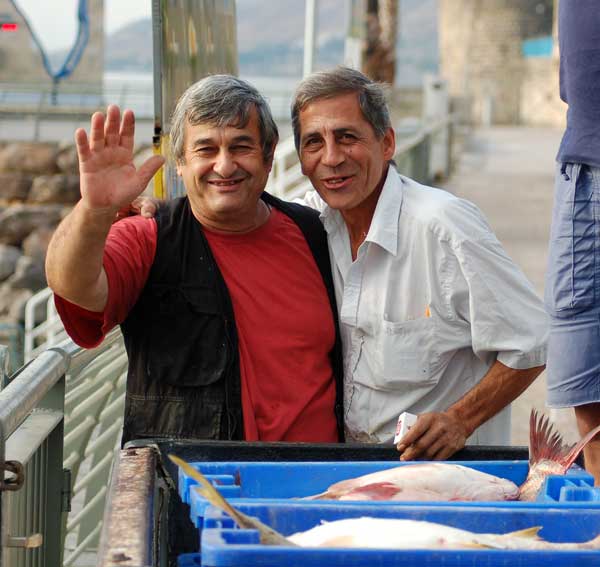FISHING IN GALILEE RECENT AND PAST

ISRAEL PHOTOS IV -- Pilgrimage |
FISHING IN GALILEE RECENT AND PAST

Fisherman were unloading their catch at the
Tiberias Marina after a night of fishing from a small boat.
Methods of fishing have changed through the years

Studies in Galilee, Ernest Masterman, University of Chicago, 1909 -- An account of fishing on the Sea of Galilee before motorized boats were used
Fish were caught…in the summer, chiefly from el Baailhah, the great marshy delta of the Jordan at the northeastern corner of the Lake of Galilee. From here, processions of mules, loaded with boxes of fish, make the five hours journey to Safed at least once, and often twice, in the twenty four hours--except during the Sabbath. It is indeed, as the last proviso implies, particularly for the Jews that the fish is brought. So great is the demand that fish is often cheaper and more plentiful in Safed than Tiberias, although it is Tiberias men that do all the fishing.
Fishing off Tiberias is only followed to a considerable extent during the winter and early spring months. It is not nearly so important as that along the northern shore from Mejdel to el Bataihah. The bay at et Tabighah is, during the early months of spring, a wonderful place to fish; they swarm there, attracted by the copious hot springs which, loaded with vegetable debris, here pour their waters into the lake. For about three months--mid-January to mid-April--the fishermen make this their headquarters, erecting, a few tents or reed huts on the shore, close to the mills. While the water a few yards out teems with larger fish, the shallows in shore swarm with small fry fish.
The fishing off el-Bataihah is by far the most valuable on the whole lake. Here, close to the mouth of the Jordan, as well as in the waters of that river, fish may be taken all the year round--though varying in kind according to the season. The fishermen, whose homes are in Tiberias, make temporary reed-mat shelters for themselves while on shore, beside which they spread out their nets along the beach to dry (cf. Ezek. 24:5, 14: 47:10). It is interesting to notice that this, the richest fishing ground, is closest to the ruin et Tell, which is generally acknowledged to be the site of the village of Bethsaida, the “place of fishing,” which, according to Josephus, was afterward officially renamed Julias.
At el Huleh and the Ain el Mellahah stream (which flows into the lake) fishing is carried on by very primitive methods. The Bedawin fishermen occupy a mat hut, made of papyrus, on the eastern shore, close to the Jewish settlement of Ezbaid. During the day they catch fish by means of the “cast net,” as will be described; but at night they employ boats and use the m’batten.
From the Lake of Galilee fish is carried fresh to Safed, Nazaraeth, and other places in Galilee, and is dried and salted for the Damascus, Jerusalem markets. From et Huleh and Ain Mellahah fish is sent to Safed, to Merj ‘Ayun (five or six hours away), and to Damascus. In the case of the latter special precautions have to be taken; the fish (musht and barbut) is caught toward the evening, is sorted out on reed mats, and packed and dispatched the same night. Salted fish is also sent from here to Zahleh and other places in the Lebanon. During the summer months fish cannot be sent, in a fresh state, far from the lakes; most of it goes to Safed, and in this season almost all of it consists of carp and barbell. (This was before there were trucks in Palestine and the fish were transported by mules).
The average price of the best fish in Safed is from ten to fourteen piastres a rotl, or about four pence a pound. Catfish, which is always cheaper, may be as low as a third of this when there is a glut on the market.
Almost all the fish are caught by means of nets, of which there are three kinds: the “cast net” or shabakeh, the “draw net” or jarf, and the m’batten. The old-fashioned method of poisoning fish is still at times resorted to by amateurs. At Tiberias crumbs of bread mixed with cochineal (which appears to be a fish poison) are thrown on the water, and I am told that even ‘arak (spirits of wine) is also sometimes used. The Arabs at ‘Ain el Mellahah sometimes capture the fish in the pool by means of poison, and they also, when the weather is getting colder, and the fish by instinct make for the deeper waters, stretch nets across the stream and make big hauls. Yet another method employed at times at Tiberias is that of using weighted string of sharp, unbaited hooks which are rapidly drawn through the water, and, if skill is used, often come up with several impaled victims.
Continued: Studies in Galilee, Ernest Masterman, University of Chicago 1909
Nazareth Synagogue
Churches of the Annunciation
Latin Tradition -- Mount of
Precipitation
Nazareth Aerial View
Museum of the Basilica
Hot Springs at Tiberias
Stone Water Jars at Capernaum
Capernaum
Tabgha
Bethsaida
A 1909 Galilee Fishing Description
The Giant Mustard Plant
Kursi and the Gadarene Demoniac
Jar of Ointment
Cana
Wheat and Tares